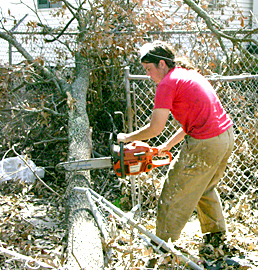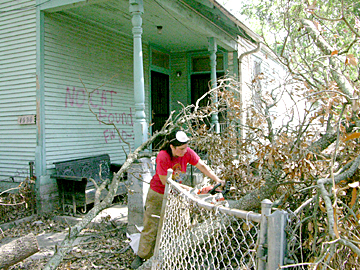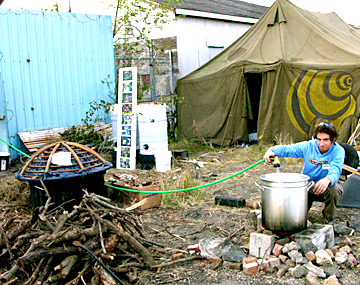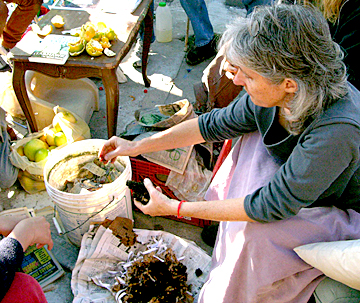Our new all-devices website!
Visit RQ at our new wix-based, all-devices website. Same great RQ content, now viewable on phones, tablets, etc.
This site (ReclaimingQuarterly.org) is still fully functional, but is no longer being updated.
Visit us at WeaveAndSpin.org!

playlists, streaming and downloads
Links to free listening
at youtube, google, spotify, and more!
Favorite RQ Features
 Older
Features Older
Features

|

Features from New Orleans
* denotes most recent updates
Bioremediating New Orleans: Round Two Begins
Photos and text by Starhawk
February 10, 2006
Flying into New Orleans reading Jared Diamond's Collapse, a whole history of societies throughout history that have collapsed, mostly through destroying their environment, deforestation, soil erosion, and related mistakes. I can't help thinking that historians of the future will look back on New Orleans' destruction in last summers' hurricanes with the same kind of incredulity as we ponder the Easter Islanders' cutting of their last trees.
"How could they not have seen what they were doing?" they might ask. "They knew that hurricanes would come, that the levees were inadequate." That historian might go on to mark the summer of the hurricanes as the watershed moment for the American Empire, the point where its collapse became evident, if not in the lack of preparations for the disaster, then in the utter failure of every major institution to respond adequately. "It wasn't the beginning of the end, but it was the point where the end became visible."

Pagan Cluster activists help with the hard work of clearing debris
Or not. They might come to a different conclusions. if they were here with me in the Common Ground office called the House of Excellence, sitting in on our Bioremediation team meeting, watching Emily's eyes light up with excitement as she says, "We're really doing it - we're really going to clean the whole thing up!"
In the front room is a bank of computers with open, free internet access open to the community. In the side rooms are offices, a small kitchen. A young man with wild, dark hair spends half an hour reading one of the Narnia books to a three young girls here for daycare. Jen, Randy, Juniper and I are all deep in books on phytoremediation and beneficial fungi and compost teas and doing computer searches as we pull together the material for tomorrow's public forum on the toxic residues here in New Orleans and our plan for the weekend's bioremediation training.
Working with these young women - it's like having a team of Hermione Graingers at our disposal, young, incredibly smart, beautiful, and willing to dive into books and internet sites and come up with answers to almost any question, if answers exist Juniper, who middle aged, beautiful and incredibly smart, and in fact in her day job is a respected environmental engineer, shows us her map - she has taken the EPA testing data, 75,000 pieces of information posted on their website in obscure and intimidating detail, put it together with her own data and plotted it on a map that shows the sites tested and the toxins found for all of New Orleans.

Frontline bioremediation lab.
Now that we know where the hot spots are, (or at least, the one's they've tested) and what the problems are, we can decide what will be the most effective ways to clean them up, using beneficial bacteria, or mushrooms, or plants. It sounds simple, but there are many complexities. Petrochemicals can be broken down by bacteria and fungi, but heavy metals are elements, and can't be broken down. Some plants and mushrooms will extract them from the soil, but some of them need different conditions to work well. Lead, for example, is most soluble when the soil is acidic, and needs special chelating agents to be taken up in quantities. Arsenic, one of the most common pollutants, is most soluble when the soil is alkaline. We can find references to plants that will take it up, but where the hell do we get seeds for Alpine Pennycress or spores of Ladder Brakefern? The methods we would use to uptake metals in plants are exactly contradictory to those we might use to bind them into the soil in a form that will be less harmful to other life forms. Which do we do?
It's exciting. It's also uncharted territory. Lots of people have worked on bioremediation, in the lab, on highly toxic sites, in well funded cleanup efforts. We don't know of anyone who has tried it on a low-budget, mass movement backyard scale.
February 13, 2006
Two days of intense research, followed by the forum and two days of training. The forum went well, with about a hundred people crowded into the gutted front room of the church that is hosting Common Ground's Community Center on the east side of town. We had the usual technical problems - Juniper's great maps that showed so clearly on the computer didn't show up at all when projected onscreen, but otherwise lots of good information and enthusiasm.
Because of the hurricane, the EPA has now tested New Orleans for a whole host of contaminants. The EPA has not tested the back yards of Brooklyn or Chicago or Detroit - but chances are if they did they would find many of the same contaminants as in New Orleans. Katrina didn't create the arsenic or the diesel fuels, she just spread them around. Some came from industrial spills and refineries, of course. But the lead and the arsenic, probably the most wide-spread contaminants, were already in the soil. Louisiana has a generally high background level of arsenic in its soils, but much of what is here now probably comes from using treated lumber, herbicides, pesticides and lawn chemicals. One piece of data seems to highlight this issue: the Sun Done garden, an organic garden for fifteen years, tests in the safe zone for all the major contaminants, including arsenic. Other backyards, just a few blocks away, test high. Thinking about how to bioremediate these toxins brings us back around to think about how insane it is to be putting them onto the ground in the first place. On the larger scale, bioremediation means learning to grow food organically and live sustainably I the first place.

Sorting worms to help with soil regeneration.
Saturday we began our training at the Sun Done Community Garden, one of sixty coordinated by a nonprofit called Parkway Partners. It's a big piece of ground, maybe half an acre, tucked between the back yards of houses in a residential area that flooded heavily and is still mostly deserted. When I was here in November, the garden was a shambles, the greenhouse in pieces on the ground, only one or two beds in shape to plant. Now, the Common Ground crew, spurred by Lisa and Emily, have done a miraculous work of transformation. The raised beds and reconfigured and are growing greens and vegetables that we've been eating at the Community Center. The greenhouse has been re-erected, covered with new plastic, and fittled with gutters and rain catchment that have filled half a dozen barrels of water from last night's downpour. There's a small compost toilet in the back and room for seating and training inside the greenhouse.
We were expecting somewhere between ten and thirty people, and made handouts for fifty, thinking we'd have extras. But people begin swarming in, and soon the greenhouse is filled and overflowing.
We spend the day going over the toxins that have been found in New Orleans' soil, and the three basic methods of bioremediating them - using microorganisms, using fungi and mushrooms, and using plants. We divide people into different groups for hands-on practice, making compost, starting worm bins (worm castings are the major source for the microorganisms we culture), starting seeds and taking cuttings, and inoculating strata with mushroom spawn.
And then we spent Sunday teaching about fungi and using plants to accumulate heavy metals. Part of our project will be to put up a website with all our data and information, and to do some documented trials to learn much, much more about how all this might work. There's lots more to tell, but I'm going to send this first report out now, while I have internet access.
More later, Starhawk
Starhawk is an activist, organizer, and author of The Earth Path, Webs of Power: Notes from the Global Uprisin, The Fifth SacredThing and other books on feminism, politics and earth-based spirituality. She teaches Earth Activist Trainings that combine permaculture design and activist skills, www.earthactivisttraining.org, and works with the RANT trainer's collective, www.rantcollective.net, that offers training and support for mobilizations around global justice and peace issues. Contact www.starhawk.org
How You Can Help
Donations are urgently needed for all aspects of the rebuilding effort. You can donate directly to Reclaiming folks working in New Orleans via PayPal by clicking this link:
Donate to the Pagan Cluster's New Orleans work.
If you want to support a local New Orleans grassroots group with whom Reclaiming is working, you can donate to Common Ground at their website: www.commongroundrelief.org
For more information
Email katrina@pagancluster.org
There is also useful and updated information at the following web-sites:
www.commongroundrelief.org
www.pagancluster.org
|



